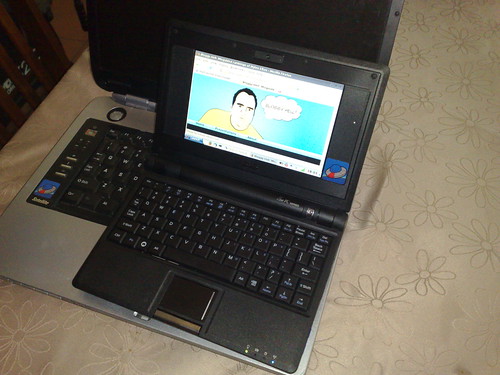I’m writing this blog post using my brand-spanking Eee PC – the 7″ mini-laptop brought out by Asus. This thing is small, I’ve taken a picture of it sitting on my regular 15″ widescreen laptop, and you can see the difference:

They have managed to squeeze a pretty decent machine in there – it is a 900Mhz Celeron (under clocked to 630Mhz) with 512Mb of RAM and 4Gb of SDD drive space, not bad considering the size and the fact it weighs less than a kilo! Even with the specs, it is suprisingly zippy – I suppose because there isn’t really anything running on it. Boot up time is less than a minute, and shutdown is even quicker.
There is an 8Gb one as well (exactly the same, just with a bigger drive), but I threw in a $25 2GB SD card and that suits me plenty.
It comes loaded with Xandros Linux, a Debian derivative, and with a little hacking, you can unlock the less than useful “simple” mode to reveal KDE. So me further hacking still, and you can pretty much load up any software that will run on Linux. I have a LAMP stack, and I nearly have Rails working (getting Rails to work on Debian is a pain at the best of times).
One of the other great things about this machine is the hackability – many people have managed to install internal USB hubs and bluetooth adapters, touch screens and even digital tv tuners behind the screen (I’m very tempted by this…).
Alas, there are a few downsides. The battery life is pretty average (mind you I’ve been spoilt by my extended 5 hour battery on my main laptop) and hibernation takes longer than shutting down, so the default action when shutting the lid is sleep, which surprisingly chews through the battery. I had it fully charged the night I got it, closed the lid and it was almost dead by morning.
The keyboard takes a little getting used to (but what do you expect). For example, I keep hitting PgUp instead of shift.
The only other annoyance (and this is probably a Linux thing more than anything else) is the WiFi doesn’t auto-connect and it doesn’t seem to like JoikuSpot, so I’m still stuck with my iPod Touch on the train.
All in all though, for a $AU500 miniature laptop, it is freaking awesome!
